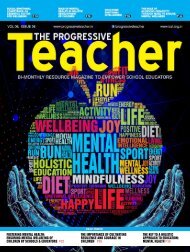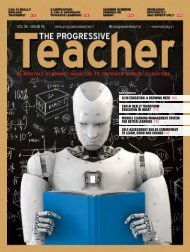The Progressive Teacher Vol 02 Issue 04
This issue of The Progressive Teacher focuses on "Teaching- Emotional Fulfillment and Self-Actualisation". The magazine provides guidance to the teachers by their peers and school leaders for tackling challenges with innovative ideas. Happy Reading!
This issue of The Progressive Teacher focuses on "Teaching- Emotional Fulfillment and Self-Actualisation". The magazine provides guidance to the teachers by their peers and school leaders for tackling challenges with innovative ideas. Happy Reading!
You also want an ePaper? Increase the reach of your titles
YUMPU automatically turns print PDFs into web optimized ePapers that Google loves.
nutrition<br />
Here comes the role of education. If<br />
we educate ourselves about various<br />
aspects of food, we can stay healthy<br />
and can guide our future generation to make<br />
good choices regarding healthy intake<br />
of nutrients.<br />
THE LUNCH BOX TREND<br />
Bread jam,<br />
parantha with<br />
potato vegetable,<br />
noodles, bread<br />
toast, pakora,<br />
sandwich, etc, have<br />
been observed as a common lunch box trend.<br />
This type of lunch is not only rich in one type<br />
of nutrient i.e carbohydrates but also lacks<br />
various other nutrients. Several schools have<br />
introduced fruit break and weekly menu<br />
system to increase the intake of fruits and<br />
green vegetables in the diet. Some of the<br />
government aided schools introduced mid-day<br />
meal programme to improve upon physical<br />
growth of the children. In metro cities, where<br />
the parents are busy with fast life-style<br />
trends, the lunch box is often replaced by<br />
cash to be paid in the canteen.<br />
CANTEEN FOOD<br />
Pastry, chips,<br />
crunches, burgers,<br />
patties, pakora,<br />
ice-cream, pizza,<br />
cold drinks, etc,<br />
are the most<br />
common items available in any canteen<br />
within the school or near the school premises.<br />
Teenagers are especially more attracted<br />
towards the canteen culture. Many a time<br />
there are no proper storage units in the<br />
canteen and hygiene is not maintained. In<br />
such cases, food contamination leads to<br />
food borne infections and food poisoning by<br />
bacteria like E. coli and salmonella.<br />
This is the right time to think about the<br />
quality of food we are offering to the younger<br />
Busy lifestyle and rapid<br />
industrialization have<br />
boosted the food industry<br />
with abundance of food<br />
choices. A wide variety of<br />
processed food available in<br />
supermarkets, restaurants<br />
and streets, equipped with<br />
attractive packaging, enticing<br />
smell and efficient services,<br />
triggers unavoidable<br />
temptation. Aggressive<br />
advertising, diet fads, vested<br />
business interests, etc adds<br />
to this. Every day we hear<br />
news about food poisoning<br />
and poor nutrition in our<br />
diet. This disturbs us and we<br />
are left wondering whether<br />
we are consuming the right<br />
food or not? So it becomes<br />
important for us to learn<br />
how to make the right choice<br />
about food.<br />
generation. Food that is low in hygiene and<br />
nutritive qualities - is this food or junk?<br />
JUNK FOOD<br />
Calorie rich and nutritionally poor food is<br />
called junk food. It is rich in carbohydrates<br />
and fat with hardly any proteins, vitamins<br />
and minerals. In today’s scenario, junk<br />
food has created a niche in our society by<br />
replacing traditional<br />
cooking. This has<br />
undoubtedly led<br />
to diseases like<br />
diabetes, obesity,<br />
cardiovascular<br />
diseases, cancer<br />
and other health<br />
ailments. Junk food has an addictive tendency<br />
and provides enough taste that you don’t even<br />
bother to chew your food but swallow packets<br />
of chips and cookies and still are ready to<br />
eat more. Junk food lacks fibre and is thus<br />
consumed in higher quantities to satify the<br />
appetite. After consuming junk food one is<br />
not likely to eat healthy food like fruits and<br />
vegetables.<br />
FOOD AWARENESS<br />
Food that looks very attractive in the market<br />
is actually chemically processed with a<br />
number of food additives such as flavouring<br />
agents, colouring agents, taste enhancers and<br />
preservatives. New techniques are emerging<br />
day by day to make food more aesthetically<br />
pleasing because of market<br />
competition.<br />
<strong>The</strong> chips and<br />
crunches<br />
contain a<br />
chemical<br />
called<br />
Olestra<br />
that<br />
has a<br />
tendency<br />
to block the<br />
absorption of vitamins<br />
A, D, E and K. This leads to prevention of<br />
essential functioning of these vitamins in the<br />
body and as a result the physical and mental<br />
growth of a child is affected.<br />
Sugary drinks, candies, ice-creams, sweets<br />
and cake toppings contain artificial chemical<br />
colouring agents. <strong>The</strong>se chemicals are<br />
48 <strong>The</strong> <strong>Progressive</strong> <strong>Teacher</strong> Sep/Oct 2015


















